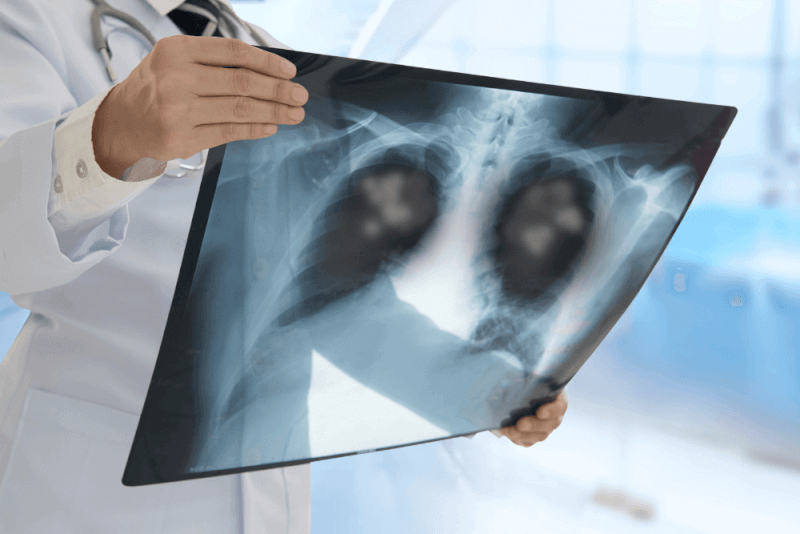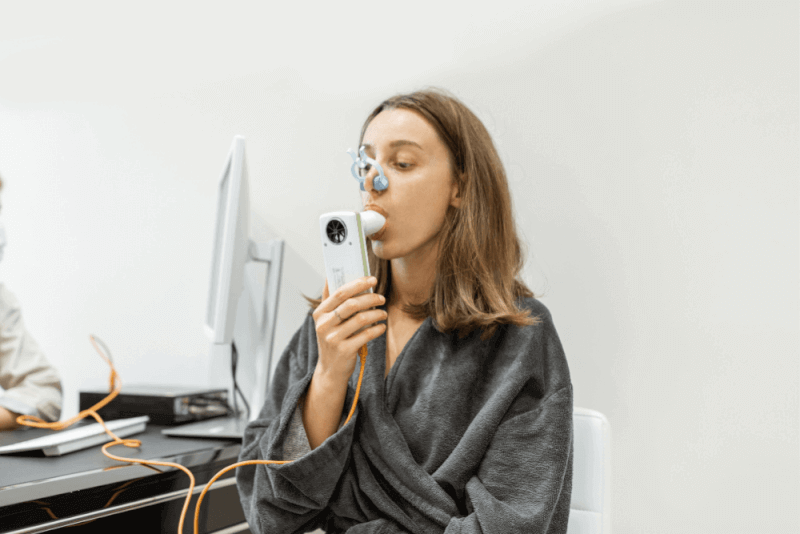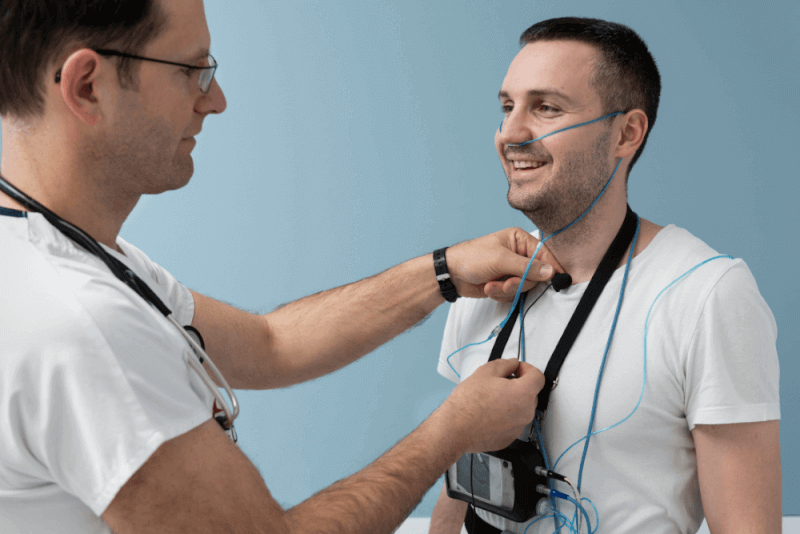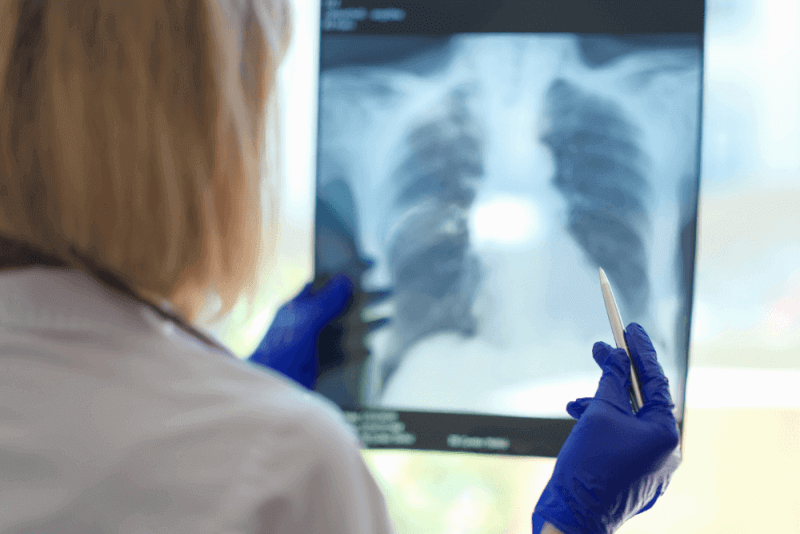What is Pneumonia?
Pneumonia, also known as pneumonia in the general public, is a type of infection that causes inflammation of the air sacs in one or both lungs. The air sacs can fill with fluid or pus, leading to phlegm-producing cough, chills, and difficulty breathing. Viruses, bacteria, and fungi can cause pneumonia. The severity of pneumonia can range from very mild to life-threatening.
Diagnosis Criteria for Pneumonia
To diagnose pneumonia, specialists first question the patient about their symptoms. They then perform a physical exam to check for abnormal sounds in the lungs. If pneumonia is suspected, the following tests and imaging methods may be requested.
- Blood tests to confirm the presence of an infection and identify the pathogen causing the infection
- Chest X-ray to diagnose pneumonia and understand its extent
- Pulse oximetry to determine the level of oxygen in the blood
- Sputum test to identify the cause of the infection
If patients are over 65 years old or show severe symptoms, additional tests may be requested, including:
- CT scan if pneumonia does not resolve within the expected time frame
- Pleural fluid culture test with a needle to help determine the type of infection
Symptoms of Pneumonia
The symptoms of pneumonia vary depending on the type of pathogen causing the infection, the patient's overall health, and age. Mild symptoms are often similar to those of the flu or a cold but last longer. Bacterial pneumonia symptoms can appear gradually or suddenly. Symptoms of bacterial pneumonia may include:
- High fever
- Cough with yellow, green, or bloody mucus
- Loss of appetite
- Confusion or changes in mental state
- Fatigue
- Bluish skin, lips, or nails
- Chest or abdominal pain when coughing or taking deep breaths
- Sweating or chills
- Rapid breathing
- Rapid heart rate
- Shortness of breath
Symptoms of viral pneumonia usually develop over a few days and include symptoms similar to those of bacterial pneumonia as well as:
- Dry cough
- Extreme fatigue or weakness
- Muscle pain
- Headache
Newborns with pneumonia may not show any symptoms, but common symptoms in newborns include:
- Vomiting
- Fever
- Cough
- Irritability
- Fatigue and lack of energy
- Difficulty breathing
- Difficulty eating
Parents should watch for the following symptoms in infants and young children:
- Feeding difficulty
- Crying more than usual
- Lethargy
- Pale skin
- Less urination
- Grunting sound with noisy breathing
Adults over 65 or those with weakened immune systems may experience less noticeable symptoms. Continuing health conditions can worsen these symptoms, which may include:
- Exhaustion
- Loss of appetite
- Sudden change in mental state
Causes of Pne umonia
Many different pathogens can cause pneumonia. Common causes include bacteria and viruses that can be transmitted through the air. Under normal conditions, the body's defense system prevents these microbes from reaching the lungs. However, sometimes these pathogens can overcome the immune system, even in generally healthy individuals. Although pneumonia can affect anyone, children under 2 and adults over 65 are considered high-risk groups. Other risk factors for pneumonia include:
- Being hospitalized for any health condition, especially treatments in intensive care units
- Having asthma, COPD, or heart disease
- Smoking
- Having a weakened immune system
Common diseases that can lead to pneumonia include:
- Common cold (rhinovirus)
- COVID-19
- Flu
- Human metapneumovirus (HMPV)
- Human parainfluenza virus (HPIV)
- Legionnaire's disease
- Mycoplasma pneumonia bacteria
- Pneumococcal disease
- Pneumocystis pneumonia
- Respiratory syncytial virus (RSV)
Treatment of Pneumonia
The main goal of pneumonia treatment is to cure the infection and prevent complications. Patients with community-acquired pneumonia are usually treated with medication at home. While the symptoms may ease within a few days or weeks, fatigue can last for more than a month. The specific treatments for pneumonia depend on its type, severity, the patient's overall health, and age. Treatment options include:
Antibiotics
Determining the type of bacteria causing pneumonia and prescribing the appropriate antibiotic can take some time. If symptoms do not improve despite antibiotic use, different antibiotics may be prescribed.
Cough Medicine
Cough medicines can help calm the cough and allow patients to rest. However, because coughing helps loosen and expel fluid from the lungs, the cough should not be completely suppressed. There are few studies examining whether over-the-counter cough medicines reduce pneumonia-related cough. Patients should use the lowest dose necessary to help them rest.
Fever Reducers and Pain Relievers
These medications are prescribed to reduce fever and discomfort in patients. Medications that may be prescribed include:
- Aspirin
- Ibuprofen
- Acetaminophen
Hospitalization
Hospitalization may be required if any of the following occur:
- Being over 65 years old
- Experiencing confusion about time, people, or places
- Decreased kidney function
- Blood pressure dropping below 9/6
- Rapid breathing
- Difficulty breathing
- Body temperature below normal
- Heart rate below 50 or above 100
Patients may need treatment in intensive care units if they require a breathing machine or have very severe symptoms. Additionally, children may need to be hospitalized in the following cases:
- Being younger than 2 months old
- Dehydration
- Lethargy or excessive sleepiness
- Low blood oxygen levels
- Difficulty breathing
Classification of Pneumonia
Pneumonia is classified based on the type of pathogen causing the disease and where the infection was acquired. Types of pneumonia include:
Community-Acquired Pneumonia
The most common type of pneumonia, community-acquired pneumonia occurs outside hospitals or other healthcare facilities. Causes include:
Bacteria
The most common cause of bacterial pneumonia is Streptococcus pneumoniae. This type of pneumonia can occur alone or after the flu. It is called lobar pneumonia because it affects one lobe of the lung.
Bacteria-Like Organisms
Mycoplasma pneumoniae can also cause pneumonia. It generally causes milder symptoms than other types of pneumonia. This type of pneumonia is often referred to as "walking pneumonia" because it usually does not require bed rest.
Fungi
Fungal pneumonia is seen in people with chronic health problems or weakened immune systems and results from inhaling large doses of organisms. Fungi that cause pneumonia can be found in soil or bird droppings. Fungal contamination varies by geographic location.
Viruses
Viruses that cause colds and flu can also cause pneumonia. Viruses are the most common cause of pneumonia in children under 5 years old. Viral pneumonia is usually mild but can become severe. Coronavirus can cause severe pneumonia.
Hospital-Acquired Pneumonia
Hospital-acquired pneumonia occurs when patients hospitalized for another health condition contract pneumonia. Hospital-acquired pneumonia can be very serious because the bacteria causing it may be more resistant to antibiotics, and the patient's overall health is often already compromised. Patients on ventilators in intensive care units are at higher risk for this type of pneumonia.
Healthcare-Associated Pneumonia
Healthcare-associated pneumonia occurs in people living in long-term care facilities or receiving care in outpatient clinics, including kidney dialysis centers. This type of pneumonia is caused by bacteria and may be resistant to antibiotics.
Aspiration Pneumonia
Aspiration pneumonia can occur if food, drink, vomit, or saliva enters the lungs. Conditions that disrupt normal gag reflexes, such as brain injury or swallowing problems, increase the risk of aspiration pneumonia.
What are the Risks of Pneumonia?
Even with treatment, patients may face complications, especially those in high-risk groups. Potential complications of pneumonia include:
Bacteremia
Bacteria from the lungs can enter the bloodstream and spread the infection to other organs, potentially leading to organ failure.
Difficulty Breathing
Severe symptoms or the presence of another chronic condition can make it difficult to breathe enough oxygen. In this case, hospitalization and the use of a breathing machine may be required.
Pleural Effusion
Pneumonia can cause fluid to accumulate in the space between the layers of tissue lining the lungs and chest cavity. If the fluid becomes infected, it may need to be drained with a chest tube or surgery.
Lung Abscess
A lung abscess occurs when pus forms in a cavity in the lung. Most lung abscesses are treated with antibiotics, but some may require surgery or drainage.
How Should Pneumonia Patients Eat?
Diet plays an important and active role in supporting pneumonia treatment. Both patients and those recovering from pneumonia should include the following foods in their diet to recover quickly:
Honey
Honey is recommended for pneumonia patients because it helps reduce annoying symptoms such as cold cough and sore throat. Mixing lemon and honey can help relieve symptoms.
Turmeric
Chest pain, an early symptom of pneumonia, can be reduced due to turmeric's anti-inflammatory effects. Turmeric, which also serves as a mucolytic, helps clear mucus from the bronchial tubes, making breathing easier.
Yogurt
The healthy bacteria in yogurt prevent the growth of bacteria that cause pneumonia. In addition to yogurt, other probiotics such as kefir can be consumed. Probiotics are one of the most important foods to include in the diet because they strengthen the immune system.
Protein-Rich Foods
A protein-rich diet is recommended for pneumonia patients because protein helps heal and regenerate body tissues. Protein-rich foods include nuts, peanuts, white meat, beans, cold-water fish, and red meat.
Whole Grains
Pneumonia patients often experience a decrease in energy. To replenish lost energy, consuming plenty of carbohydrates is essential. Quality carbohydrate sources such as oats, brown rice, and quinoa are recommended.
Cruciferous Vegetables
Cruciferous vegetables, also known as leafy greens, are very nutrient-dense. These foods help patients recover and contain antioxidants that protect the body from pathogens.
Vitamin C
Vitamin C, an antioxidant, also helps strengthen the immune system and aids in the recovery from pneumonia. However, if you have a sore throat, avoid eating acidic fruits like oranges. Instead, choose other fruits such as strawberries and kiwis.
Foods to Avoid for Pneumonia Patients
Pneumonia patients should reduce or eliminate the following foods from their diet:
Salt
Although salt is healthy for the body, it can cause edema. Excessive edema can increase the risk of respiratory problems. Therefore, patients should consume limited amounts of salt.
Milk and Dairy Products
Kazomorphin, found in milk and dairy products, increases mucus in the intestines. Therefore, it is recommended that pneumonia patients avoid consuming these products.
How to Prevent Pneumonia?
To help prevent pneumonia, the following points should be considered:
- There are vaccines that prevent certain types of pneumonia and flu. Discuss with your doctor to determine if you should get the pneumonia vaccine, which will protect you against some types of pneumonia.
- A different pneumonia vaccine is recommended for children under 2 and those between 2 and 5 years old who are at risk of pneumonia. It is recommended that children in daycare centers be vaccinated. Additionally, children over 6 months old should receive the flu vaccine.
- Regular hand washing is essential to protect against respiratory infections that can cause pneumonia.
- Quit smoking.
- Strengthen your immune system.








